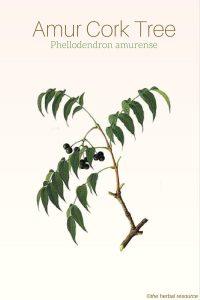The active constituents of this herb are berberine, jatrorrhizine, magnoflorine, candicin, palmatin, obacunone, 7-dihydro stigmasterol, beta-sitosterol, and campesterol. Amur cork tree has both antimicrobial and antibiotic properties due to the alkaloids present in the plant.
Amur cork tree bark has a strong bitter taste and is best known as diuretic and cooling herb that stimulates the liver and gallbladder. It has been used traditionally to lower fever and to reduce blood pressure and blood sugar levels.
It has a strong antibacterial effect and has been used internally to treat diarrhea, dysentery, enteritis, vaginal infections, acute urinary tract infections, abscesses, tumors, jaundice, night sweats and skin diseases
The fruit has an expectorant effect and is sometimes used to treat the symptoms of a cold.
It is one of the 50 most important herbs in Chinese herbal medicine and is one of the ingredients in the Chinese medicine San huang zhe She ye (“injection of three yellow herbs”).
The other two herbs are Chinese goldthread (Coptis chinensis) and baical skullcap (Scutellaria baicalensis). This herbal medicine is used internally to treat infections of the upper respiratory tract.
Animal studies have shown this herb did lower blood pressure when injected directly into the bloodstream.
Amur cork tree has been used externally with some success for the treatment of eczema around the ears.
Recently conducted research has shown that it can be useful in the treatment of meningitis and conjunctivitis. A preparation of the bark was used to treat 20 cases of meningitis in patients who were between the ages of four and 24.
Those with mild symptoms showed improvement the very first day, but it took an average of eight days before the symptoms were completely gone. One study showed a positive effect on conjunctivitis in children. A high concentration of the herb gave the best results.
A yellow plant color can be obtained from the tree’s inner bark. Oil can be extracted from the seeds and used as an herbal insecticide. The wood is hard and strong and is used in furniture making. The bark is often used as a substitute for cork.
[Read more about Amur Cork Trees…]

Leave a Reply